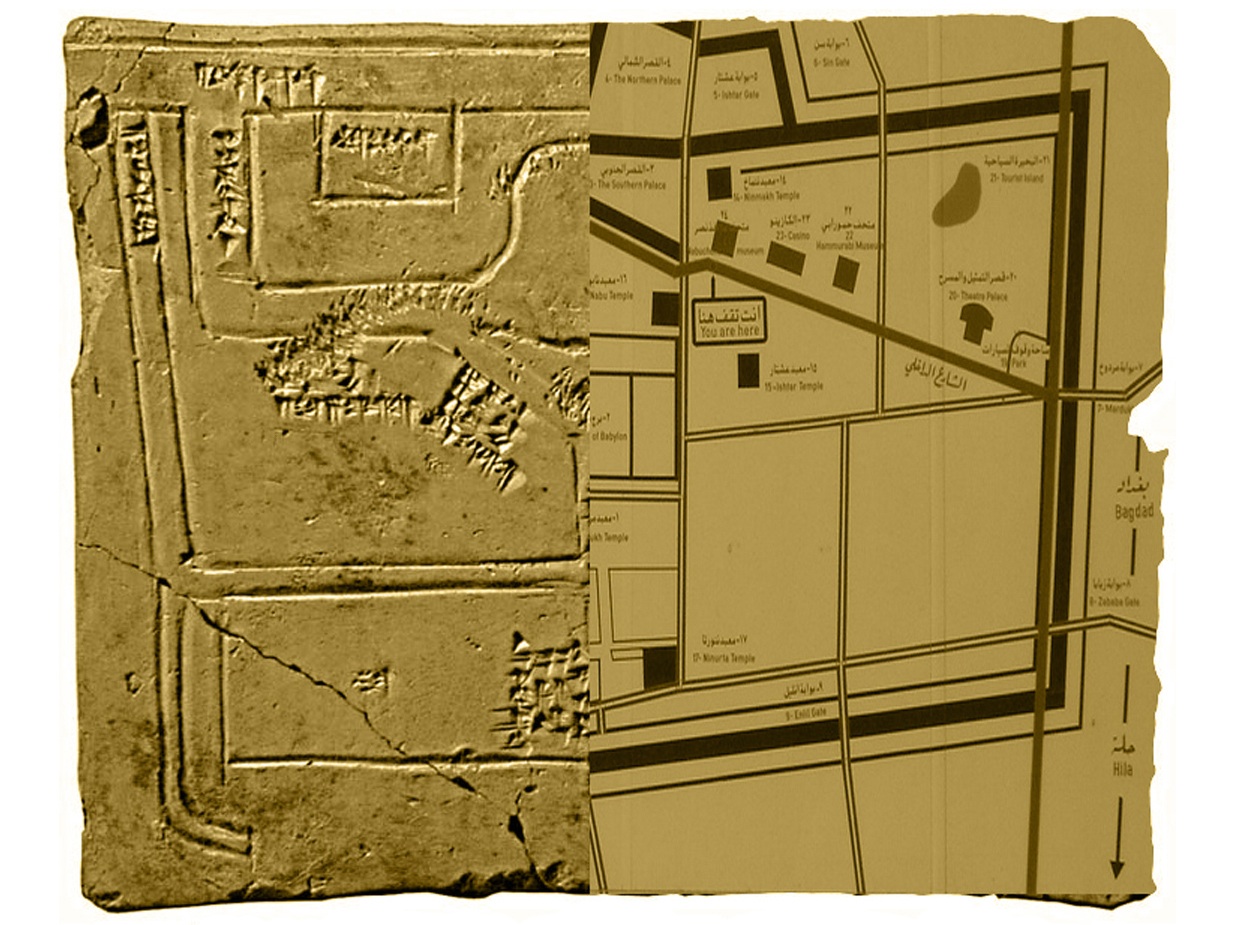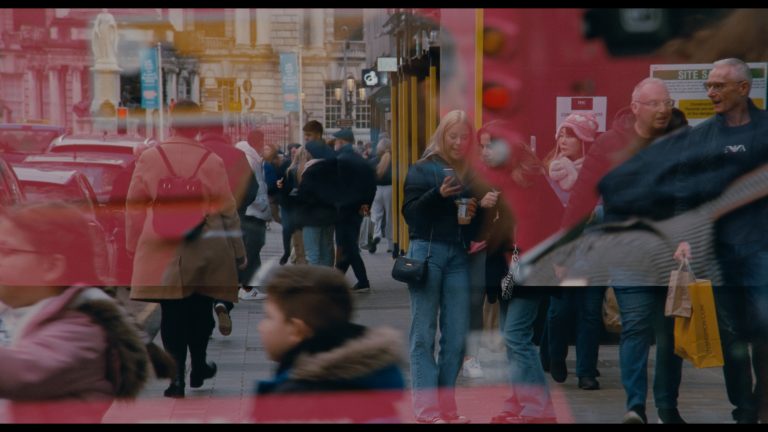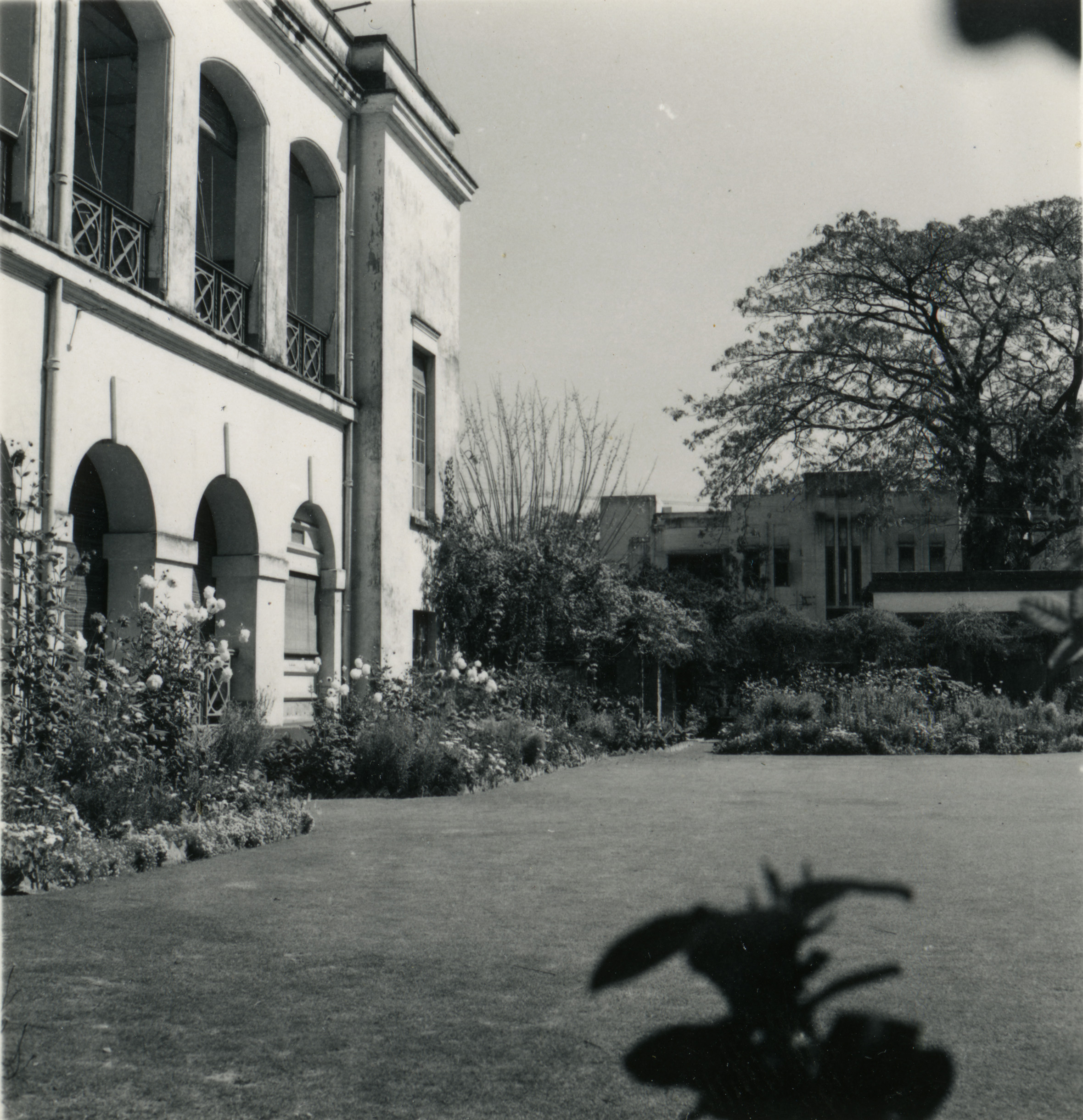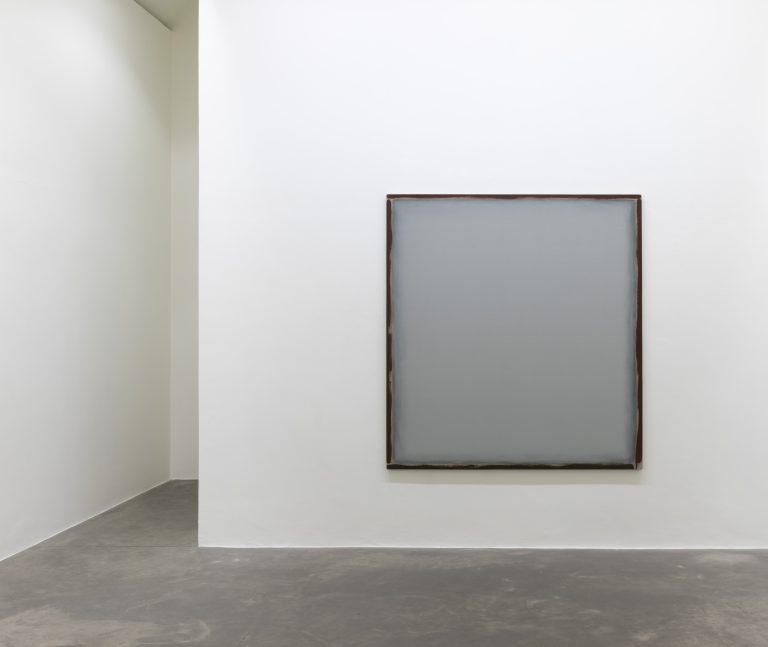Babylon is associated with the anti-Christ and it is said to be the seat of power for the tyrant of the world. The Bible states that Babylon (present day Al Hillah which is 85 miles south of Baghdad), would be destroyed and never rebuilt, a Christian prophecy that Saddam Hussein found irresistible to prove wrong. He began the reconstruction of his new Babylon just three years into his presidency. For Saddam Hussein, his restoration program would seal his place in history as the restorer of the ancient city, sending out a resounding visual message to the Christian West. His grandiose plans of resurrection involved building on top of the foundation stones of King Nebuchadnezzar’s Palace (c.600 B.C.) with bricks embossed with his own inscriptions.

Angela Darby & Robert Peters: “In the era of Saddam Hussein, protector of Iraq, who rebuilt civilization and rebuilt Babylon
SDH,” silk-screen, ink, card
installation shot
Image courtesy of the artists.
Screenprinted onto the walls of Platform Arts Gallery, an artist-led space on Queen Street, Belfast, is the text from Saddam Hussein’s bricks: “In the era of Saddam Hussein, protector of Iraq, who rebuilt civilization and rebuilt Babylon. SDH.” The artists have left the silkscreen, ink and squeegee used for stencilling the text on a pallet nearby, accompanied by a pile of card also printed with the same inscription. The low-tech quality of the assemblage suggests a quick and inexpensive method for the creation of multiples, which chimes well with the rumour that Saddam Hussein’s bricks were so cheaply manufactured that they were crumbling within a few years of production. His inscribed bricks have now become treasures for souvenir seekers.
Historians and archaeologists working in Iraq ridiculed Saddam Hussein’s Babylon project as ‘Disney for a Despot.’ He only succeeded in defacing invaluable archaeological sites and artefacts by trying to replace them with his own grandiose vision.
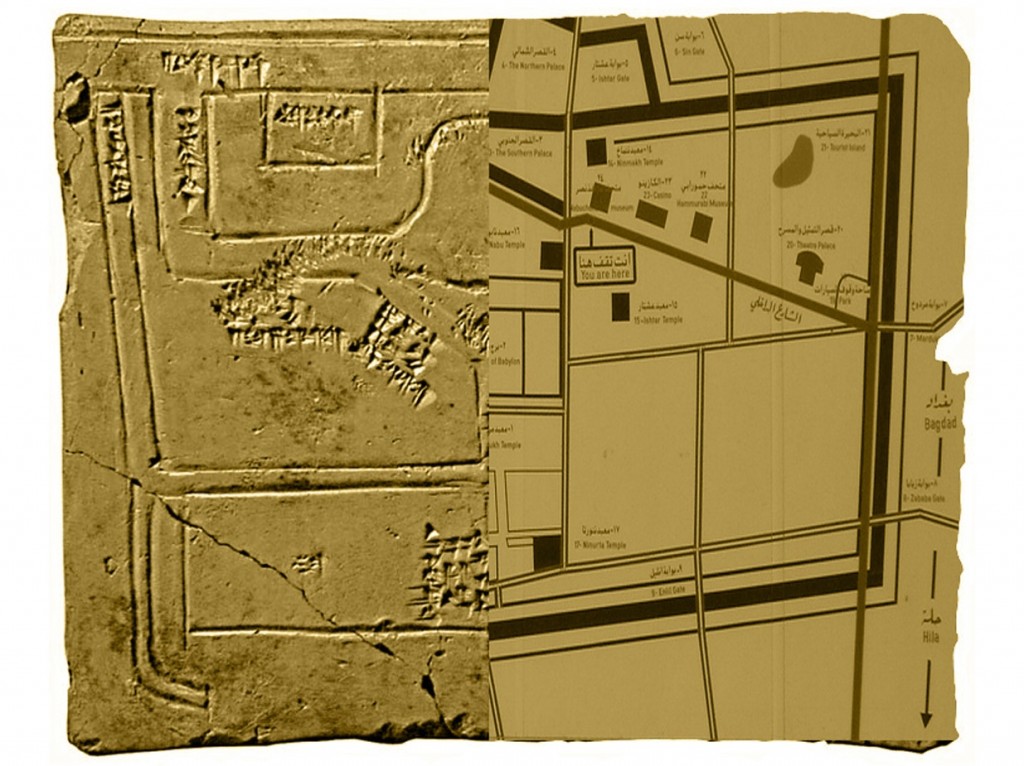
Angela Darby & Robert Peters: Babylon theme park,
digital print collage on paper 2011
image courtesy the artists.
Angela Darby and Robert Peters, both Northern Irish artists, work in collaboration to the point that both artists work on any individual artwork together, that they share the processes of making. This development in their collaborative practice can also be seen in relation to an exhibition of their Barbican Gatehouse Project in Antrim in December 2009. Here, the artists’ concerns with the aesthetics of power were investigated in relation to the local Antrim town council’s handling of the Gatehouse and the local town crest, and in turn the access to these ‘public’ properties.
The aesthetics of local Baghdad governance are also investigated here with the piece entitled Babylon theme park which presents two maps; one of the ancient city, the other of the modern, newly recreated Babylon. They are sliced, torn and then attached with one sandwiched between the other. Saddam Hussein’s lofty intention was to mimic King Nebuchadnezzar II, but his attempts to develop the ancient city eradicated rather than enhanced Mesopotamia’s heritage. By associating himself with Nebuchadnezzar, Hussein further attempted to convince the Iraqi people (and the Arab nations) of their rightful place in history.
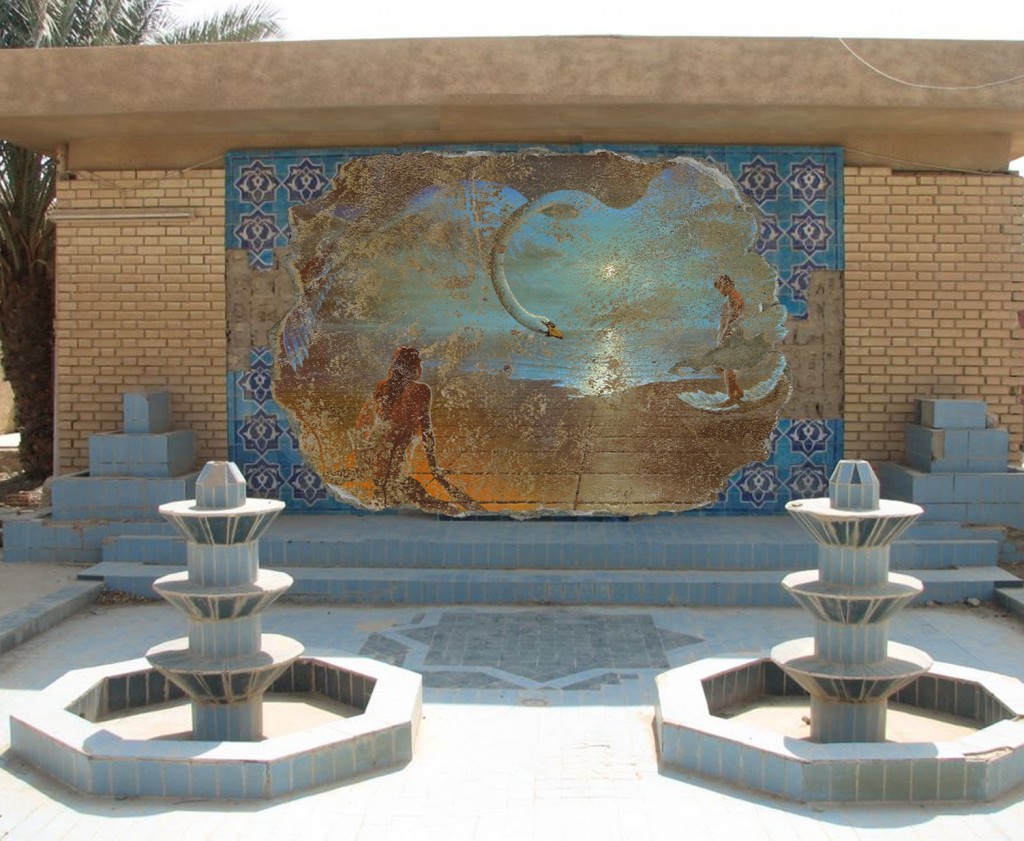
Angela Darby & Robert Peters: Saddam’s Palace
digital photograph
Image courtesy of the artists.
Rumour has it that Stephen Pearson’s kitsch painting The wings of love (c.1972) was originally commissioned by Saddam for a wall beside one of his many swimming pools in his palace. The murals’ central section is projected onto the back wall of the gallery and presented like an ancient artifact removed from its original setting. An accompanying publication informs us that Pearson sold over 3.5 million prints of this picture during the 70s and 80s. The image of the mural incongruously placed at one of Saddam’s swimming pools points to a mismatch between cultural norms, a reflection on some Middle Eastern leader’s relationship with Western power.
An old monitor sitting on a rusty set of shelves displays a documentary featuring Dr. Donny George Youkhanna, former Head of the Board of Antiquities in Baghdad. His voice resonates throughout the gallery. Dr Youkhanna describes the catastrophic events of his return to the Iraq Museum on the 13th April 2003. Between the 8th and 12th, fighting had broken out on the museum grounds and the museum employees had fled. Thousands of priceless historic and archaeological relics belonging to the ancient Sumerian civilization and other periods of Mesopotamian history had disappeared from storerooms. Dr Youkhanna believed that approximately fifteen thousand items were destroyed or stolen and that bizarrely many of the cuneiform tablets were auctioned on e-Bay. Images of the damaged museum are shown revealing the extent of the devastation with the repositories of records emptied and left to rot. In the footage the viewer catches a brief glimpse of The wings of love mural taken from Saddam Hussein’s palace. By showing the mural ‘salvaged’ from the pool wall and placed in a museum the artists ask us to consider the ways in which cultural value operates and it’s absurd nature.

Angela Darby & Robert Peters: Persian rug in a swimming pool
found digital photograph
Image courtesy of the artists.
A found photograph showing a Persian rug half immersed in a swimming pool seems to capture a snapshot of the artists’ intentions. This valuable object is carelessly discarded and left in a tenuous situation, the chlorine treated water damaging the submerged fibres. Without proper assessment and protection objects of cultural importance can be lost; equally, cultural importance can be distorted by context.
Rashida Sadiq is a writer based in London.

